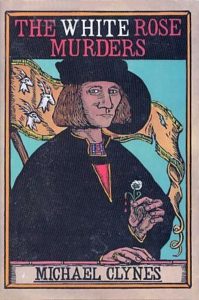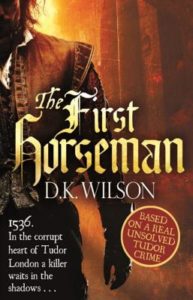What is it about the Tudors that attracts us so? Is it the pomp and excess of the Tudor monarchs? The bigger-than-life personalities? The passion and the danger? The reversals of fortune that could end in a violent and public death? The reasons are as numerous as the number of readers drawn to this era in British history.
The Tudor Dynasty lasted a little over 100 years, from 1485-1603, but their rule was one of the most dramatic and unforgettable in European history. The period sat on the cusp of modern society—influenced by the European Renaissance, yet haunted by superstitions from the medieval past.
Plenty of authors use the Tudors as a springboard for their stories, and I’m one of them. Rather than focus on the politics and imbroglios associated with nobility, my Bianca Goddard Mysteries tell the stories of commoners—people with no political clout, but who must navigate their king’s peevish policies.
Bianca is the daughter of an alchemist, a group of men who were both mocked and revered; who were doomed to ultimate failure. My heroine is well-acquainted with presumptuous and ludicrous characters. Deceit is not exclusive to the royal court, but is inherent in the fabric of society, all the way down to the lives of commoners, whose stories I enjoy writing.
Beyond C.J. Sansom’s Matthew Shardlake, and Nancy Bilyeau’s Joannah Stafford series, there are surprisingly few historical mysteries set during Henry VIII’s reign as compared to Elizabeth’s. But if you like your Tudor fare influenced by the most brutal king in British history, Henry VIII, here are some reads that are worth a look.

The White Rose Murders by Michael Clynes
“Murder raps on my door every night. When the sky is dark and a hunter’s moon hides behind the clouds, Murder sweeps up to this great manor house to kill my sleep and plunder my dreams…” So begins The White Rose Murders by Michael Clynes (Paul Doherty).
This is book one in a series of memoirs told by Sir Roger Shallot, a ninety-year-old spy for Cardinal Wolsey during King Henry VIII’s reign. Roger Shallot is, in the author’s words, “a great teller of tall tales, but he may not be a liar.” Indeed, Shallot is a rogue prone to exaggeration, a bit of a Falstaff turned spy character, and if you can tolerate the many boastful asides where he claims to have inspired Shakespeare and ravished numerous women (including Catherine de Medici), you will be rewarded with a lively story with roots firmly grounded in Doherty’s impressive grasp of history.
The scene is set in 1517, when the English have defeated the Scots at the Battle of Flodden. James IV of Scotland has been killed and his widow, Margaret, sister to Henry VIII, flees to England, leaving her children behind and her crown under a Council of Regency. Cardinal Wolsey, first minister to King Henry, enlists his bright nephew, Benjamin Daunbey, and his friend, Roger Shallot, to resolve certain mysteries that would restore Margaret to her throne.
They interview a half-mad physician named Selkirk imprisoned in the Tower, only to find him poisoned shortly thereafter in a locked chamber guarded by soldiers. He leaves behind a poem of riddles and the murderer leaves a white rose—the mark of Les Blancs Sangliers, a secret society plotting the overthrow of the monarchy and restore it to the House of Yorks. There are plenty of bodies and twists in this plot for Daunbey and Shallot to unwind. The White Rose Murders is a fun read featuring a colorful narrator, period humor, and an excellent framework of factual history.

The First Horseman by D.K. Wilson
The book is first in a series of Tudor historical mysteries based on actual, unsolved crimes.
In the early hours of a misty November morning in 1536, a prominent mercer named, Robert Packington is gunned down on his way to mass. The assassination by handgun was the first ever recorded in London. The murderer was never identified and the crime remains unsolved.
Thomas Treviot is a young goldsmith reeling over the recent loss of his father and wife. When he learns his friend has been assassinated, Treviot vows to find the murderer. What follows is a serpentine journey through Southwark, the mercantile districts, Austin Friars, Greenwich, and St. Paul’s to uncover the motivation and possible culprit responsible for the crime.
London, 1536 was a tumultuous time where King Henry has executed Anne Boleyn and is wrangling over the politics and definitions of his ‘reformed’ church. Heretics are burned, Tynsdale’s translated bible is smuggled into port, Lutherans and their ideas of reform, fall in and out of favor. Clerics are seeing their entire way of life, and their faith, turned upside down.
Wilson succeeds in capturing the flavor of this extremely volatile time, incorporating actual figures from the period and exploring their possible links to the crime.
The First Horseman is a carefully thought out and plausible explanation for Packington’s death based on the interrelationships of ministers, bishops, reformists, and the complex machinations of politics and religion.
The Cardinal’s Court by Cora Harrison
Cora Harrison’s The Cardinal’s Court is book one in a new series featuring Hugh Mac Egan, an Irish Brehon, (lawyer). Mac Egan arrives at Cardinal Wolsey’s Hampton Palace in 1522 to draw up a marriage contract between Thomas Butler, the son of the Irish Earl of Ormond, and Anne Boleyn. The marriage would have settled a title and land dispute between the two families interpreted differently under Irish and English law. But Anne Boleyn only has eyes for Harry Percy, the son of the Earl of Northumberland.
When a member of Cardinal Wolsey’s staff is found murdered, incriminating evidence calls into question Butler’s involvement. Harry Percy and Anne Boleyn are happy to implicate Butler in the crime, and it is up to Mac Egan to prove his client’s innocence in a land where a man is guilty until proven innocent.
Harrison creates a likable character in Hugh Mac Egan, and her characterization of historical figures is done without resorting to clichés that have unfortunately attached themselves to the more familiar names of the era. Harrison’s research and endnote includes interesting details and insight—she is an author who maneuvers within the bounds of documented historical accounts. Readers who love their Tudor lawyers will enjoy this addition to the genre.
Apricots and Wolfbane by K.M. Pohlkamp
Not a mystery book per se, Apricots and Wolfbane does have plenty of murders. Lavinia Maud is an assassin, a woman practiced in poisons, who uses her talents to earn a living. Her reputation and desire to be acknowledged by a clandestine poison guild compels her to take on increasingly dangerous marks. Though she enjoys killing, she does not do it without conscience. She reasons that a local priest’s absolution clears her soul for the next dastardly deed. But her life becomes even more complicated when the love of her life—the local magistrate, discovers the truth.
Read this one for the plot, not for the period detail because there is disappointingly little that grounds the story in the Tudor era. Indeed, the author was inspired by the life of Locusta, a poison master employed by the Roman Emperor Nero and the narrative could have been comfortable in any century. However, the balance of religion, conscience, and murder is thoughtfully done and like any good mystery, the heroine’s fate is not revealed until the end.



















